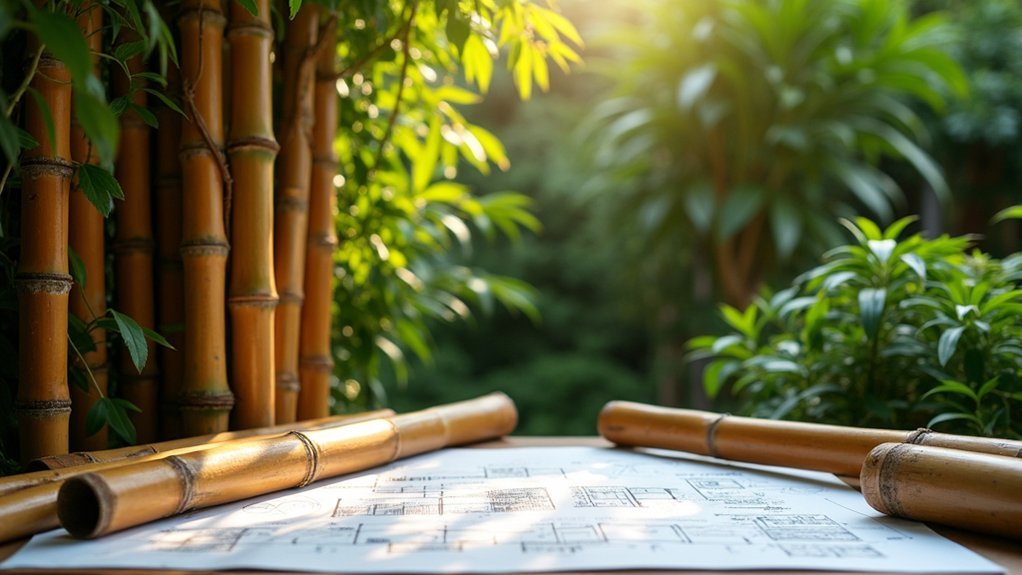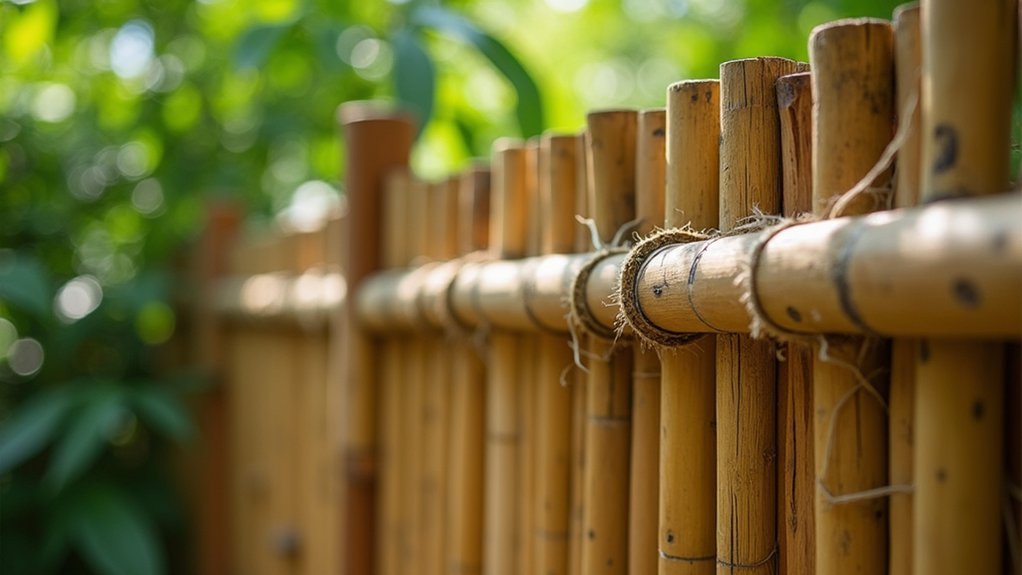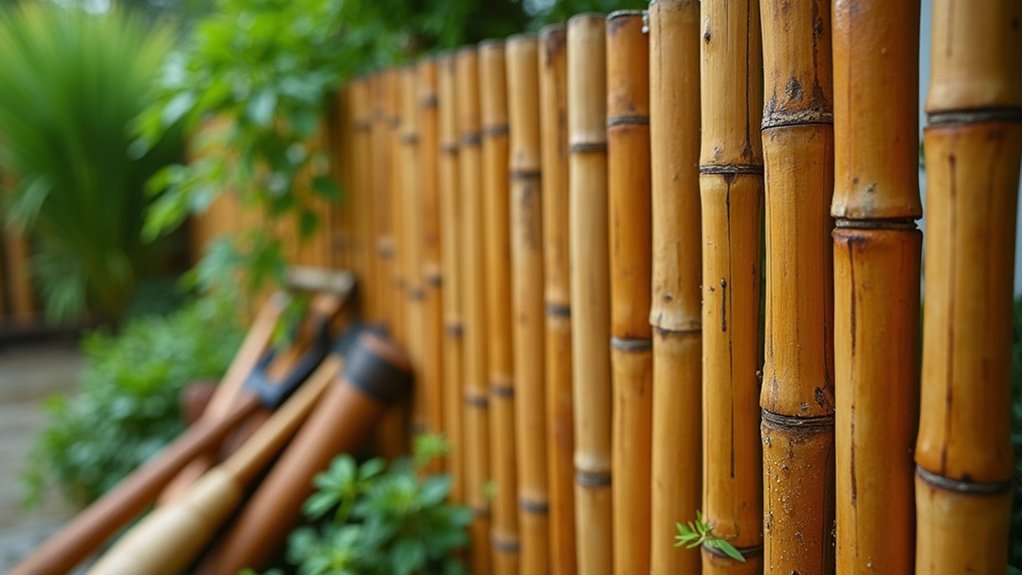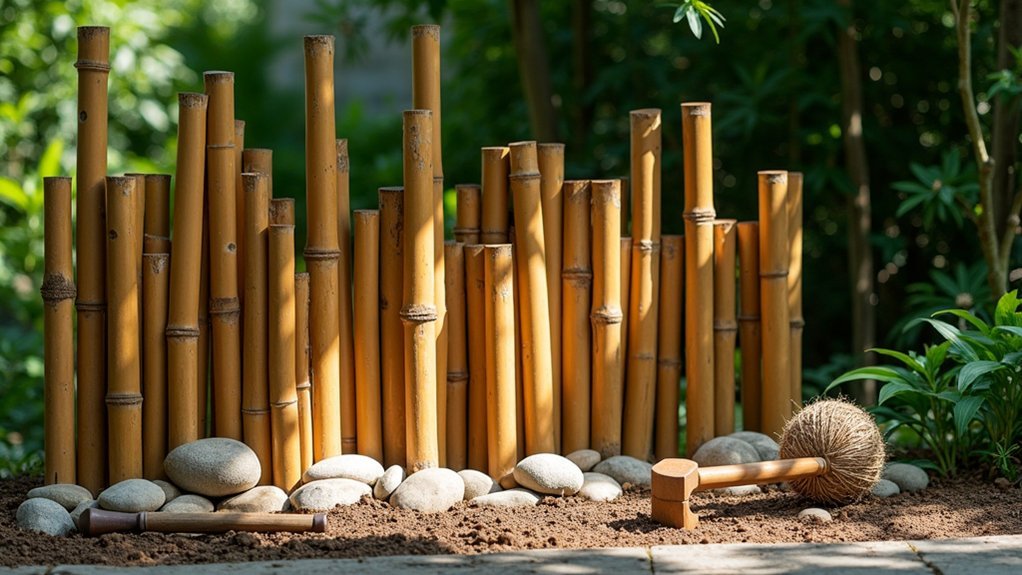Installing a Japanese bamboo fence requires careful planning and preparation. First, choose a style that matches your garden’s character and verify local building codes. Clear and level the area, then install sturdy posts at even intervals. Secure bamboo canes using traditional lashing techniques with hemp twine, ensuring nodes align at joints for strength. Apply weather-resistant sealant before and after installation. With proper maintenance every 2-3 years, your authentic garden boundary will stand the test of time.
Planning and Choosing Your Japanese Bamboo Fence Style

When commencing on a Japanese bamboo fence installation, careful planning and style selection lay the foundation for a successful project.
Begin by determining your fence’s purpose—privacy, boundary marking, or aesthetic enhancement—while considering your site’s unique conditions like sunlight exposure and soil type.
Select a style that reflects your garden’s character. The intricate Kenninji-Gaki suits temple-inspired spaces, while Misu-Gaki offers contemporary elegance.
For a balance of traditional and modern, consider Shimizu Gaki. If you prefer an open design, Yotsume-style provides a traditional lattice pattern, while Kinkakuji-style features distinctive round poles.
Remember to check local building codes and consider the fence’s adaptability to your terrain.
Choose sustainable materials that align with your environmental values while complementing neighboring properties.
Site Preparation and Required Materials
After selecting your ideal bamboo fence style, proper site preparation and gathering the right materials will set you up for installation success.
Begin by clearing the area of debris and plants, ensuring the ground is level, and marking post locations with rope. Use a soil auger to dig holes for wooden posts and assess drainage needs. Applying a protective sealant to posts from top to bottom will prevent rotting and extend the life of your fence.
Your materials checklist should include:
- Bamboo canes (60mm and 100mm diameters) selected for straightness, uniform color, and strength
- Wooden posts (160mm diameter) for the main support structure, plus smaller wooden pieces for securing uprights
- Hemp twine or waxed lashing cord for knotting, along with fine wire or slender nails for reinforcing joints
You’ll also need tools like hammers, mallets, saws, measuring tape, and knowledge of specialized knotting techniques like Ibo and Tambuchi knots.
Building a Sturdy Frame for Your Bamboo Installation

The foundation of any successful bamboo fence installation lies in creating a robust, well-aligned frame. Start by selecting durable wood or metal for your posts, then dig holes at least one foot deep for stability.
Use a level and taut string to guarantee your posts stand perfectly straight and aligned. Space your posts evenly based on your design, typically 3 feet high for Yarai-style fences.
Secure crosspieces horizontally across the posts, drilling pilot holes first for added strength. Cutting slots into the bamboo uprights helps achieve more secure attachment to horizontal rails. For a uniform appearance, measure carefully to maintain equal spacing between all elements.
You’ll need essential tools including post-hole diggers, levels, drills, and saws. Choose weather-resistant materials for longevity, especially if you’re building in an exposed area.
For Yarai-style fences, consider mounting on existing stone walls for traditional aesthetics.
Attaching and Securing Bamboo Canes With Traditional Methods
Traditional Japanese bamboo fence construction relies heavily on ancient lashing techniques that have withstood centuries of testing. When securing your bamboo canes, choose the appropriate knot based on your fence’s design—square lashings work well for perpendicular joints, while diagonal lashings reinforce corners where strength is vital.
For authentic Japanese fence construction:
- Position bamboo poles with nodes strategically placed at joint points for maximum structural integrity.
- Apply even tension when wrapping your chosen natural fiber rope (jute works beautifully) around intersecting poles.
- Secure each lashing with a proper finishing knot, tucking loose ends away for a clean aesthetic.
Remember to drill small holes through nodes rather than internodes when creating anchoring points, as this preserves the bamboo’s natural strength while allowing for secure attachments. Consider using the through joint technique for fence panels, which provides exceptional stability while maintaining the traditional aesthetic.
Weatherproofing and Long-Term Maintenance of Your Bamboo Fence

Every bamboo fence requires proper weatherproofing and regular maintenance to withstand nature’s elements for decades.
Before applying sealants, thoroughly clean the surface with a detergent or specialized bamboo cleaner, allowing it to soak for 15 minutes before scrubbing with a nylon brush. Ascertain the bamboo is completely dry afterward.
Apply water-resistant sealants every two to three years, ideally sealing bamboo before installation for maximum protection. Proper sealing provides essential UV protection that prevents fading and preserves the bamboo’s natural appearance.
Regularly inspect for damage, loose ties, or cracks, addressing issues promptly to prevent deterioration. In humid environments, manage moisture levels carefully and consider placing your fence in shaded areas to reduce sun damage.
Adjust your maintenance schedule based on your local climate, and keep vegetation trimmed to prevent excess moisture that leads to rot.
Frequently Asked Questions
Can Bamboo Fences Be Installed in Snowy or Freezing Climates?
Yes, you can install bamboo fences in snowy or freezing climates. They’ll last up to 20 years when properly finished, raised off the ground, and attached with screws rather than nails to prevent cracking.
How Do I Prevent Animals From Damaging My Bamboo Fence?
To prevent animal damage, install your bamboo fence with underground extensions, apply natural repellents like garlic spray, maintain regular inspections, remove nearby food sources, and consider adding motion-activated lights to deter nighttime intruders.
Are Permits Required for Installing Bamboo Fences?
Yes, you’ll likely need permits for bamboo fences depending on your local regulations. Check with your municipality about height restrictions, zoning bylaws, and property line requirements before starting your installation project.
Can I Grow Climbing Plants on My Bamboo Fence?
Yes, you can grow climbing plants on your bamboo fence. Choose compatible climbers like hydrangea or roses, plant them 1-1.5 feet away, and use weatherproof supports to distribute weight evenly across the fence.
How Do Bamboo Fences Affect Property Values?
Bamboo fences can both enhance and potentially decrease your property value. They’ll add aesthetic appeal and privacy when well-maintained, but if you don’t control invasive species, you’ll risk property damage and neighbor disputes.
In Summary
You’ve now completed your Japanese bamboo fence, adding authentic Asian elegance to your landscape. With proper maintenance, it’ll last 15-20 years. Remember to treat it annually with protective oil and check for any loose bindings or damaged canes. Your effort has created not just a boundary, but a stunning focal point that transforms your outdoor space into a serene, Zen-inspired retreat.





Leave a Reply